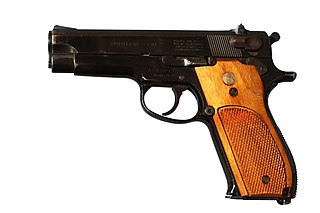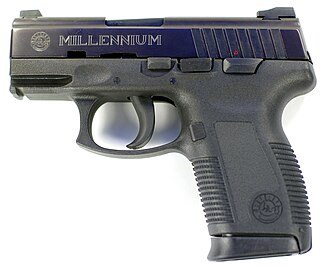
Smith & Wesson Brands, Inc. (S&W) is an American firearm manufacturer headquartered in Maryville, Tennessee, United States.

Glock Ges.m.b.H. is a light weapons manufacturer headquartered in Deutsch-Wagram, Austria, named after its founder, Gaston Glock. The company makes popular polymer-framed pistols, but also produces field knives, entrenching tools, various horse related products, and apparel.

The .40 S&W (10.2×22mm) is a rimless pistol cartridge developed jointly by American firearms manufacturers Smith & Wesson and Winchester in 1990. The .40 S&W was developed as a law enforcement cartridge designed to duplicate performance of the Federal Bureau of Investigation's (FBI) reduced-velocity 10mm Auto cartridge which could be retrofitted into medium-frame semi-automatic handguns. It uses 0.40-inch-diameter (10 mm) bullets ranging in weight from 105 to 200 grains.

The Walther P99 is a semi-automatic pistol developed by the German company Carl Walther GmbH Sportwaffen of Ulm for law enforcement, security forces and the civilian shooting market as a replacement for the Walther P5 and the P88. The P99 and its variants are also made under licence by Fabryka Broni Radom.

The Smith & Wesson 5906 is a pistol manufactured starting in 1988 by Smith & Wesson.

The Ruger P series is a line of centerfire semi-automatic pistols made by Sturm, Ruger & Company produced from 1985 to 2013. The P-series pistols were designed for military, police, civilian and recreational use. The designs are largely based on the Browning action found in the M1911 pistol, but with minor variations, generally related to the safety mechanism and the barrel-camblock interface. Reviews have considered them rugged, reliable, and strong, though this strength comes at the price of bulk and a blocky appearance.

In American English, a pocket pistol is any small, pocket-sized semi-automatic pistol, and is suitable for concealed carry in a pocket or a similar small space.

The Steyr M is a series of semi-automatic pistols developed by Steyr Mannlicher GmbH & Co KG of Austria for police services and the civilian shooting market. Design work on the new pistol began in the early 1990s and the final product known as the M9 was officially unveiled in the spring of 1999. The M40 version chambered in .40 S&W was developed before the M9, followed later by the M357 and two smaller variants of the M9 and M40 designated the S9 and S40 respectively. These pistols were developed primarily for concealed carry and have a shortened barrel, slide, smaller frame and a reduced magazine capacity. In 2013, the Steyr M (Medium) and S (Small) form factors were complemented by the L (Large) sized series and the C (Compact) sized series both available in 9×19mm Parabellum and .40 S&W chamberings as the L9-A1, L40-A1, C9-A1 and C40-A1.

The Smith & Wesson Model 39 is a semiautomatic pistol developed for the United States Army service pistol trials of 1954. After the Army abandoned its search for a new pistol, the Model 39 went on the civilian market in 1955 and was the first of Smith & Wesson's first generation semi-automatic pistols.

The Tanfoglio Force, also known as Force 99, Force 2002, EAA Witness Polymer or EAA Witness P-Carry, is a modified clone of the Czech CZ-75/CZ-85 semi-automatic pistol. It is made in Gardone Val Trompia near Brescia, Italy by Fratelli Tanfoglio S.N.C.

Kahr Arms is an American small firearms manufacturer focused on compact and mid-size semi-automatic pistols chambered for popular cartridges, including .380 ACP, 9mm Luger, .40 S&W and .45 ACP. Kahr pistols feature polymer or stainless steel frames, single-stack magazines, and double-action-only striker firing actions. Kahr Arms is part of the Kahr Firearms Group, a US-based firearms manufacturer, which also includes Thompson Auto-Ordnance and Magnum Research. The Kahr Firearms Group company headquarters is in Greeley, Pennsylvania, with a manufacturing facility in Worcester, Massachusetts.

The Smith & Wesson M&P is a polymer-framed, short recoil operated, locked breech semi-automatic pistol introduced in the summer of 2005 by the American company Smith & Wesson. It uses a Browning-type locking system. While targeted at law enforcement agencies, the M&P is also widely available on the commercial market.

A handgun is a firearm designed to be usable with only one hand. It is distinguished from a long gun which needs to be held by both hands and braced against the shoulder. Handguns have shorter effective ranges compared to long guns, and are much harder to shoot accurately. While most early handguns are single-shot pistols, the two most common types of handguns used in modern times are revolvers and semi-automatic pistols, although other handguns such as derringers and machine pistols also see infrequent usage.

Glock is a brand of polymer-framed, short-recoil-operated, striker-fired, locked-breech semi-automatic pistols designed and produced by Austrian manufacturer Glock Ges.m.b.H.
Llama Firearms, officially known as Llama-Gabilondo y Cia SA, was a Spanish arms company founded in 1904 under the name Gabilondo and Urresti. Its headquarters were in Eibar in the Basque Country, Spain, but they also had workshops during different times in Elgoibar and Vitoria. The company manufactured moderate-priced revolvers and self-chambering pistols in a wide variety of models. These were popular mainly in the European and Latin American export market, as well as domestically in Spain.

The Taurus Millennium series is a product line of double-action only (DAO) and single-action/double-action hammerless, striker-fired, short recoil operated, semi-automatic pistols manufactured by Forjas Taurus S/A in Porto Alegre Brazil. The Millennium line was designed to contend in the civilian concealed carry firearms market, and to be sold as backup weapons for law enforcement officers.

The Walther PPQ is a semi-automatic pistol developed by the German company Carl Walther GmbH Sportwaffen of Ulm for law enforcement, security forces and the civilian shooting market as a development of the Walther P99. It is available in 9×19mm Parabellum, 9×21mm, .40 S&W, and .45 ACP chamberings.

The Smith & Wesson Bodyguard 380 is a compact semi-automatic pistol produced by Smith & Wesson chambered for the .380 ACP cartridge.

The Smith & Wesson SD Series is a polymer-framed, striker-fired semi-automatic pistol line that the American company Smith & Wesson introduced in 2010, replacing the SW / Sigma line. Smith & Wesson started manufacturing "SD VE" models in 2012. The SD VE models have stainless steel slides. Aside from slide color differences, SD and SD VE pistols are mechanically identical.

The SIG Sauer P365 is a striker-fired subcompact semi-automatic pistol manufactured by SIG Sauer, intended for everyday carry. It is offered with Tritium XRAY3 Day/Night Sights and two 10-round magazines; one flush fit and the other with an extended finger tab, and a stainless steel frame with polymer grip module. It is primarily chambered in 9×19mm Parabellum and is rated for +P ammunition while utilizing offset double-stack magazines. A variant chambered in .380 ACP was introduced in February 2022. The P365, which replaced the P290RS, is produced in Newington, New Hampshire. In both 2018 and 2019, it was the best selling handgun in the United States.



















